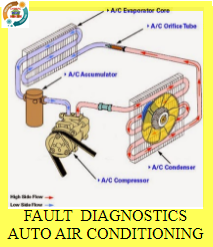REMOVAL/INSTALLATION AND
TROUBLESHOOTING FOR AIR
CONDITIONING COMPRESSORS
TROUBLESHOOTING FOR AIR
CONDITIONING COMPRESSORS
: General
The air conditioning compressor is driven by the vehicle engine .via a ribbed or V-ribbed belt. It compresses and transports the refrigerant in the system. There are different compressor designs available
How they work:
The refrigerant is sucked in as a gas under low pressure and low temperature from the evaporator; it is then compressed and forwarded to the condenser as a gas under high temperature and high pressure.
Effects of failure:
A damaged or failed compressor can manifest itself as follows:
Loss of sealing -
Development of noise -
Insufficient or no cooling performance -
Fault code is stored (automatic air conditioning) -
Development of noise -
Insufficient or no cooling performance -
Fault code is stored (automatic air conditioning) -
Caution!
Before installing a new compressor, you must check the oil quantity and
the viscosity according to the manufacturer's instructions!
There are a number of possible causes of failure:
- Bearing damage caused by a defective tensioner or by wear -
Loss of sealing of the compressor shaft or of the housing -
Mechanical damage to the compressor housing -
Contact (electrical connections) -
Lack of refrigerant oil -
Lack of refrigerant -
Solids (e.g. swarf) -
Loss of sealing of the compressor shaft or of the housing -
Mechanical damage to the compressor housing -
Contact (electrical connections) -
Lack of refrigerant oil -
Lack of refrigerant -
Solids (e.g. swarf) -
- Humidity (corrosion etc.)
Troubleshooting:
Function test and pressure measurement of the system:
- Does the compressor switch on, is the connector plug
securely in place, is there voltage?
- Check that the drive belt is positioned correctly, undamaged,
and that there is tension.
- Check visually for loss of sealing.
- Check that refrigerant tubes are securely in place.
- Compare the pressures on the high and low pressure sides.
- Read out the fault memory.
Attention must always be paid to the following:
The entire air conditioning system must be cleaned to 100 % and the
consumables must be replaced when the compressor is replaced.
The entire air conditioning system must be cleaned to 100 % and the
consumables must be replaced when the compressor is replaced.
kandi younes







